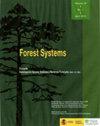Fungal diversity and colonization in roots seed trees of Swietenia macrophylla (Magnoliophyta: Meliaceae) in the tropical rainforest of Laguna Om, Quintana Roo, Mexico
IF 0.7
4区 农林科学
Q3 FORESTRY
引用次数: 0
Abstract
Aim of study: (i) To investigate the diversity of arbuscular mycorrhizal fungi (AMF) associated with the roots of seed trees stands in a conserved and natural population of mahogany (Swietenia macrophylla), based on rDNA sequences; and (ii) to evaluate the dual colonization by AMF and dark septate fungi (DSF), showing the types of fungal colonization patterns in the dry season. Area of study: Tropical rainforest of Ejido Laguna Om, Quintana Roo, Mexico. Material and methods: We evaluated the AMF and DSF colonization in secondary root segments of ten adult trees of mahogany. We analysed the diversity of AMF in one composite sample of mahogany roots (three trees) using 18S rDNA gene with Illumina MiSeq platform. Main results: Through metabarcoding 14 virtual taxa belonging mainly to the genus Glomus and Diversispore were obtained, VTX00186 being the most abundant. The percentages of colonization for the different fungal structures were hyphae 80%, vesicles 18%, coils 2%, and arbuscules 0.5%; for DSF, 60% hyphae and 12% microsclerotia. The Paris-type colonization predominated with 61% in the roots. Research highlights: The knowledge of the AMF diversity present in natural mahogany forests will allow the selection of species for inoculation management seeking to enhance seedling survival and growth of this species.墨西哥金塔纳罗奥州拉古纳奥姆热带雨林大叶甜藤根种子树真菌多样性及定植
研究目的:(i)基于rDNA序列,研究与大叶红木(swetenia macrophylla)自然保护种群种子树根系相关的丛枝菌根真菌(AMF)的多样性;(ii)评估AMF和暗隔真菌(dark - sepate fungi, DSF)的双重定殖,显示真菌在旱季的定殖模式类型。
研究区域:墨西哥金塔纳罗奥州Ejido Laguna Om的热带雨林。
材料与方法:研究了AMF和DSF在10株红木成材次生根段的定殖情况。利用Illumina MiSeq平台,利用18S rDNA基因分析了红木根(三棵树)复合样品AMF的多样性。主要结果:通过元条形码获得了14个虚拟分类群,主要属于Glomus属和Diversispore属,其中VTX00186数量最多。不同结构真菌的定殖率分别为菌丝80%、囊泡18%、线圈2%、丛枝0.5%;对于DSF, 60%的菌丝和12%的微菌核。巴黎型定植占主导地位,占61%。
研究重点:对天然红木林AMF多样性的了解将有助于选择接种管理的物种,以寻求提高该物种的幼苗存活率和生长。
本文章由计算机程序翻译,如有差异,请以英文原文为准。
求助全文
约1分钟内获得全文
求助全文
来源期刊

Forest Systems
FORESTRY-
CiteScore
1.40
自引率
14.30%
发文量
30
审稿时长
6-12 weeks
期刊介绍:
Forest Systems is an international peer-reviewed journal. The main aim of Forest Systems is to integrate multidisciplinary research with forest management in complex systems with different social and ecological background
 求助内容:
求助内容: 应助结果提醒方式:
应助结果提醒方式:


